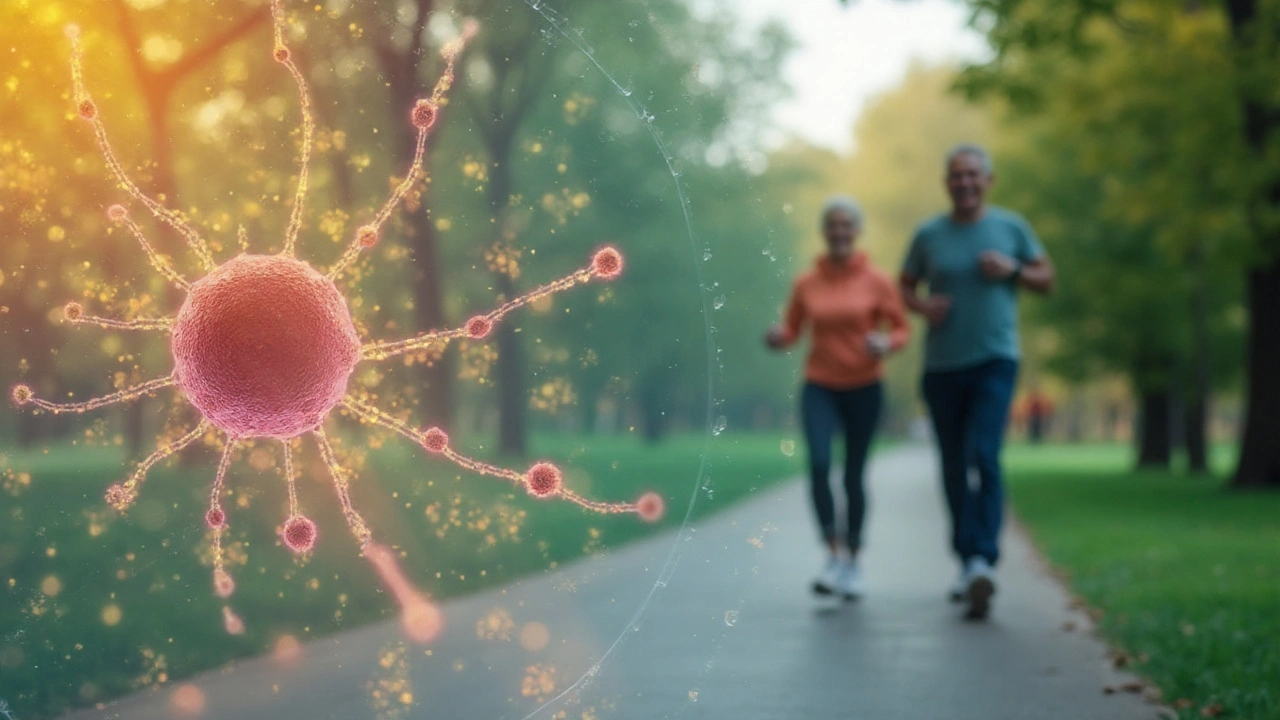Lipase is a digestive enzyme that catalyzes the breakdown of dietary fats into fatty acids and glycerol. It is naturally produced by the pancreas and also released in small amounts by the stomach. When the pancreas can’t keep up, a lipase supplement steps in to keep the digestion line moving.
Why Fat Digestion Matters
Fats are calorie‑dense, but they also deliver essential fatty acids, fat‑soluble vitamins (A, D, E, K) and provide satiety. Fat digestion starts in the mouth with lingual lipase, continues in the stomach with gastric lipase, and finishes in the small intestine where pancreatic lipase does the heavy lifting. Without enough lipase, fats linger, leading to bloating, oily stools (steatorrhea), and nutrient deficiencies.
Who Benefits Most from Lipase Supplements?
While anyone can boost their digestive efficiency with enzymes, certain groups see a clearer payoff:
- People with pancreatic insufficiency - conditions like chronic pancreatitis or cystic fibrosis reduce natural enzyme output.
- Those on low‑fat, high‑protein diets for weight loss, where missed fat breakdown can cause cravings.
- Individuals taking bile acid sequestrants (e.g., cholestyramine) that interfere with fat emulsification.
- Older adults, because pancreatic enzyme production naturally declines after age 60.
How Lipase Works Inside the Gut
Once a lipase capsule reaches the duodenum, it meets bile from the gallbladder. Bile emulsifies fat droplets, expanding surface area. Lipase then attaches to these droplets, splitting triglycerides into two‑carbon (acetyl) and three‑carbon (propionyl) fatty acids. The resulting free fatty acids are absorbed by the intestinal lining and packaged into chylomicrons that travel via the lymphatic system.
Choosing the Right Lipase Supplement
Not all lipase products are created equal. Look for these attributes:
- Enzyme potency - measured in FCC (Food Chemical Codex) units; 1,000-10,000 FCC per capsule is typical.
- Enteric coating - protects enzymes from stomach acid, ensuring they reach the small intestine.
- Combination formulas - many brands pair lipase with protease and amylase for full‑spectrum digestion.
- Third‑party testing - look for certification from NSF or USP.
Dosage Guidelines & Timing
There’s no one‑size‑fits‑all, but the following framework works for most adults:
- Start with a low dose (e.g., 500FCC) taken with the first high‑fat meal of the day.
- Observe how you feel after 3-5 days. If stools are still oily or you notice lingering fullness, increase by 250FCC per meal.
- Maximum recommended dose rarely exceeds 5,000FCC per meal, unless a physician advises otherwise.
- Take the supplement right before or during the meal - not after, as enzymes need immediate substrate contact.
People with diagnosed pancreatic insufficiency often require 2,000-10,000FCC per meal, split across multiple doses.

Safety, Side Effects & Interactions
Lipase is generally recognized as safe (GRAS) by the FDA. Reported side effects are mild and include:
- Occasional abdominal cramping if taken on an empty stomach.
- Rare allergic reactions to the capsule filler (usually soy or gelatin).
Interactions are minimal, but be cautious if you’re on anticoagulants - high doses of omega‑3 fats (often consumed with lipase to aid absorption) can augment blood‑thinning effects.
Comparing Lipase with Other Digestive Enzymes
| Enzyme | Target Nutrient | Primary Function | Typical Dosage (FCC or Units) | Common Sources |
|---|---|---|---|---|
| Lipase | Fats | Hydrolyzes triglycerides into fatty acids & glycerol | 1,000-5,000FCC per meal | Pork pancreas, microbial fermentation |
| Protease | Proteins | Breaks peptide bonds into amino acids | 10,000-30,000IU per meal | Plant bromelain, animal pancreatin |
| Amylase | Carbohydrates | Converts starches to maltose & glucose | 5,000-15,000IU per meal | Salivary glands, fungal cultures |
Connected Topics Worth Exploring
Understanding lipase opens doors to several related concepts. Below are brief links to the next logical steps in your digestive health journey:
- Gut microbiome - How beneficial bacteria influence enzyme activity and nutrient absorption.
- Pancreatic enzyme replacement therapy (PERT) - Clinical protocols for severe insufficiency.
- Fat‑soluble vitamin supplementation - Ensuring adequate A, D, E, K intake when fat digestion is compromised.
- Satiety hormones - How proper fat breakdown affects leptin and ghrelin.
- Low‑FODMAP diets - Managing gut symptoms when combining enzymes and carbohydrate restrictions.
Practical Tips for Maximizing Lipase Effectiveness
- Pair with healthy fats - Avocado, olive oil, and nuts provide the substrate lipase needs.
- Avoid high‑acid foods before dosing - Coffee or citrus can degrade uncoated enzymes.
- Stay hydrated - Fluids help disperse enzymes throughout the chyme.
- Cycle if you’re symptom‑free - Some users take the supplement only on high‑fat days to prevent tolerance.
When to See a Healthcare Professional
If you experience any of the following, schedule a check‑up:
- Persistent oily stools despite supplementation.
- Unexplained weight loss or nutrient deficiencies.
- Severe abdominal pain or vomiting.
- Allergic reactions such as rash, swelling, or difficulty breathing.
A doctor can order stool fat tests, pancreatic function labs, or imaging to pinpoint the root cause.

Frequently Asked Questions
Can I take lipase on an empty stomach?
It’s best to take lipase with or just before a meal that contains fat. Enzymes need substrate; on an empty stomach they may be degraded by stomach acid before reaching the intestine.
How long does it take to notice results?
Most people feel less bloating and more regular stools within 3-5 days of consistent dosing. Full nutrient absorption improvements may take 2-4 weeks.
Are there natural food sources of lipase?
Raw pineapples and papayas contain bromelain, which has mild lipase activity. However, the concentration is far lower than pharmaceutical‑grade supplements.
What’s the difference between lipase and pancreatic enzymes?
Lipase is just one component of pancreatic enzyme blends. Pancreatic preparations also include protease and amylase, offering comprehensive digestion support.
Can lipase help with weight loss?
Indirectly. Efficient fat breakdown reduces cravings and improves satiety, making it easier to stick to a calorie‑controlled diet.
Is it safe to combine lipase with other supplements?
Generally yes. Lipase works well with omega‑3 fish oil, vitamin D, and multivitamins. Avoid high doses of acid‑suppression meds at the same time, as they may reduce enzyme efficacy.
Do vegans need to watch lipase sources?
Most commercial lipase is derived from microbial fermentation, making it vegan‑compatible. Always check the label for animal‑derived excipients.
What lab tests confirm lipase deficiency?
A fecal fat test (72‑hour stool collection) and serum lipase activity measurement are standard. Imaging like MRCP can assess pancreatic anatomy.

Been taking lipase for a few months now with my keto meals and honestly? No more greasy toilet scenes. Life changer.
What’s fascinating is how lipase doesn’t just break down triglycerides-it’s the gatekeeper for fat-soluble micronutrient bioavailability. Without proper lipolytic activity, even if you’re consuming vitamin D-rich salmon or avocado oil, you’re essentially flushing those nutrients down the drain. The enterohepatic circulation depends on micelle formation, which requires emulsified fatty acids, and that’s where pancreatic lipase, aided by bile salts, becomes non-negotiable. In populations with chronic inflammation or gut dysbiosis, even supplemental lipase can’t fully compensate if the microbiome is too compromised to regenerate bile acid receptors. It’s not just about dosing-it’s about systemic harmony.
People underestimate how much fat digestion impacts mood and energy. When your body can’t break down lipids properly, your brain’s omega-3 supply drops, serotonin synthesis slows, and suddenly you’re tired all the time, craving carbs, and feeling foggy. Lipase isn’t just a digestive aid-it’s a cognitive support tool. I started taking it with every meal containing fat and my afternoon crashes disappeared. It’s not magic, it’s biochemistry. And if you’re not seeing results, you’re probably not taking it with enough fat. Try pairing it with a tablespoon of olive oil before your meal-game over for bloating.
Interesting how this guide ignores the fact that most people don’t need lipase supplements. The pancreas is remarkably efficient. The real issue is overconsumption of processed fats and low fiber intake, not enzyme deficiency. This feels like marketing dressed as science.
I’ve been on a low-FODMAP diet for IBS and started using lipase because I kept getting bloated even on ‘safe’ fats like coconut oil. It made a huge difference. I also noticed my skin cleared up a bit-maybe because I wasn’t dumping undigested fats into my colon anymore? I’ve been taking 2,000 FCC with my largest meal and it’s been perfect. Just wish the labels were clearer about vegan sources-I almost bought one with gelatin by accident.
Thank you for including the safety notes. I was worried about interactions with my blood thinner, but the warning about omega-3s was really helpful. I’ve been taking fish oil for years and never connected it to enzyme activity. Good to know to space them out.
So let me get this straight-you’re telling me to pay $20 for a capsule that does what my stomach has been doing for 40 years? Maybe I just need to eat less junk food instead of buying into the supplement industrial complex
Anyone else think this is all part of the Big Pharma plan to make us dependent on enzymes so they can sell us more meds later? I mean, why not just fix the root cause-like the glyphosate in our food or the EMF frying our mitochondria? Lipase is just a Band-Aid on a bullet wound. And don’t even get me started on how they use ‘microbial fermentation’ to hide the real ingredients. It’s all smoke and mirrors.
While the clinical rationale for lipase supplementation in pancreatic insufficiency is well-documented, the generalization of its utility to healthy individuals lacks robust evidence. The FCC unit system, while standardized, is not universally calibrated across manufacturers, and enteric coating efficacy varies significantly. I would recommend that laypersons consult a gastroenterologist before initiating enzyme therapy, particularly given the potential for masking underlying pathology such as early-stage pancreatitis or biliary obstruction.
It is noteworthy that the enzymatic activity of lipase is highly pH-dependent. The claim that enteric coating ensures delivery to the duodenum is only valid if the coating integrity is maintained under gastric stress. Independent studies have shown that up to 30% of commercially available enteric-coated capsules fail to protect enzymes under simulated gastric conditions. Consumers should be cautious of unsubstantiated marketing claims regarding bioavailability.